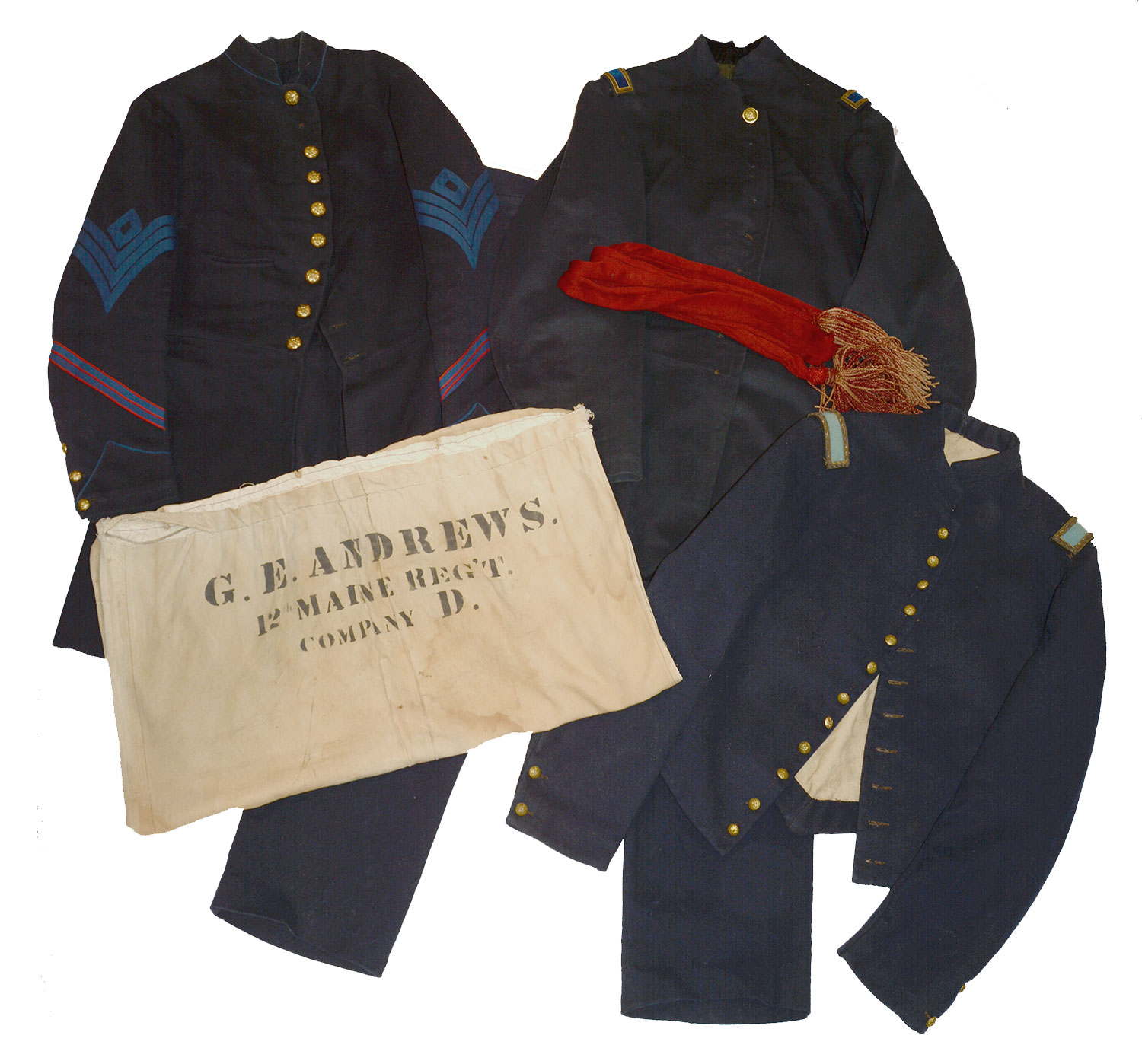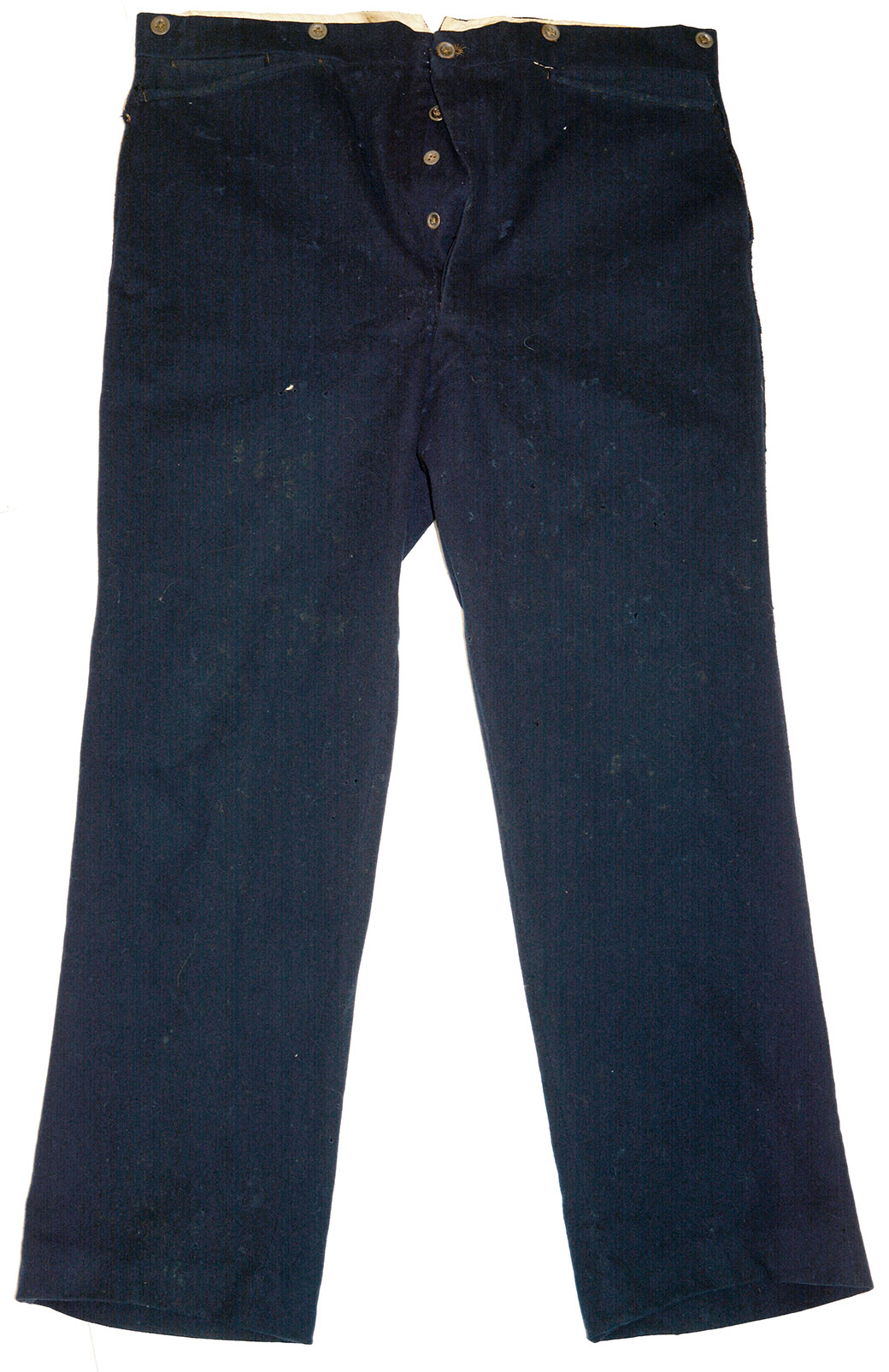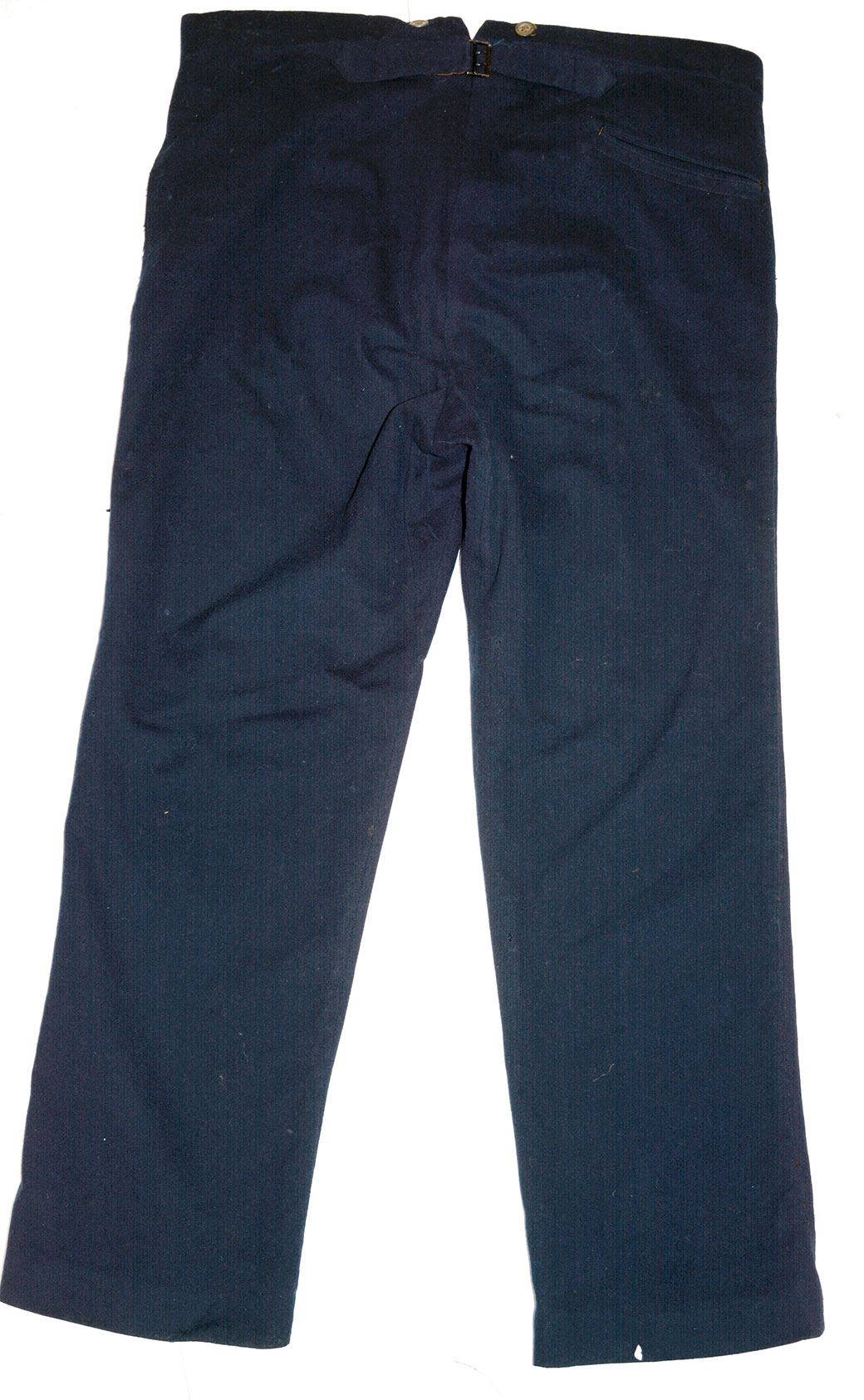site search
online catalog
FANTASTIC UNIFORM GROUPING OF G.E. ANDREWS: OFFICER’S FROCK COAT, OFFICER’S SHORT JACKET, OFFICER’S TROUSERS, AND HIS TAILOR-MADE FIRST SERGEANT FROCK COAT WITH VETERAN SERVICE STRIPES!

Hover to zoom




































$24,000.00 ON HOLD
Quantity Available: 1
Item Code: 1179-147
We don’t often use exclamation points in a description, but this identified uniform grouping, formerly in the collections of the Texas Civil War Museum, has not just historical interest, but outstanding eye-appeal. The First Sergeant’s frock coat with service stripes alone would be the centerpiece of any uniform display. Included in the group is a stenciled canvas duffel bag used by the soldier as an officer, as well as his lieutenant’s frock coat, trousers, and sash, and his field jacket, made by altering an enlisted, issue mounted services jacket.
George Ellis Andrews did two tours of duty in the Civil War. Born October 6, 1832, in Hartford, Maine, he listed himself as a carriage maker in the 1860 census and a carpenter when he joined the army. He enlisted first at age 28 in Oxford, ME, and mustered into Co. G, 1st Maine Infantry as a corporal on May 3, 1861, for ninety-days service. The regiment, composed of Maine militia and newly raised volunteers, left the state June 1 and were posted to the Washington defenses. They remained in the defenses during the Bull Run campaign and for a time thereafter guarded Long Bridge. On August 1 the regiment returned to Portland and Andrews mustered out of U.S. service with it on August 5, having suffered no casualties.
The term of enlistment for the 1st Maine provided for two years of state service, but they could not again be deployed outside the state and the regiment was disbanded, allowing many of the men to enter other units. Andrews enlisted again on October 14, 1861, joining the 12th Maine, a regiment raised to take part in Butler’s expedition against New Orleans. He mustered into Company D on November 15, either directly as First Sergeant or promoted to that rank from sergeant a few days later. (His pension records list him only as First Sergeant and Second Lieutenant in the 12th. A note on a company muster roll lists him as “promoted to 1st sergeant Nov. 15th [16th or 18th- the second digit is unclear], 1861, from the ranks.”] The regiment left the state in late November, trained for a month in Massachusetts and shipped out of Boston on January 2, 1862, arriving at Ship Island, Miss., on Feb. 12, becoming part of the Army and Department of the Gulf, and after the fall of New Orleans were posted there at the US Mint from May to October, but action in expeditions in June to Pass Manchac, where they were credited with capturing six Confederate cannon and a stand of colors, and to Ponchatoula in September. They served at Camp Parapet in October and joined Grover’s Division at Baton Rouge in November. In January 1863 they became part of the 19th Army Corps, still in the Army and Department of the Gulf, by then under Nathaniel Banks. In March 1863 they took part in operations against Port Hudson and then operations in western Louisiana in April and May, including the Teche Campaign, with actions at Indian Head, Irish Bend, and New Iberia, and participation in the advance to the Red River. In late May they were in the advance on Port Hudson and the siege from May 24 to July 8, including the assaults of May 27 and June 28. From August 1863 until March 1864 they were posted to New Orleans, Ship Island and Camp Parapet, with part of the regiment seeing action at Madisonville in January.
Andrews was among the two-thirds of the regiment reenlisting as veterans and was formally discharged in New Orleans on Dec. 31, 1863, mustering in again for three years the next day, Jan. 1, 1864. These men departed New Orleans for their veteran furlough in Maine on March 12, rendezvoused for their return on May 27, and reached New Orleans again on June 16, where they reunited with those who had not re-enlisted. In July the corps was transferred to Virginia for service under Butler again, serving in the trenches at Bermuda Hundred until July 25, and taking part in the demonstrations on the north side of the James and the Battle of Deep Bottom before marching to join the Army of the Shenandoah and Sheridan’s campaign against Jubal Early in the Valley from August 7 to November 28, fighting at Berryville, Opequon (Winchester,) where they lost 113 officers and men, Fisher’s Hill, and Cedar Creek, as part of Kimball’s brigade in Grover’s division, they suffered another 82 casualties. Alfred Waud sketched their fighting as they were forced back through their camp and over their earthworks by Early’s initial surprise attack.
In early December, after discharge of those who had not re-enlisted, the regiment was consolidated into a battalion of four companies, and Andrews was appointed acting adjutant on December 18 upon his receipt of a commission as 2nd Lieutenant from the Governor of Maine dated December 12. He performed those duties for a week and was then posted to Company C. The regiment was stationed at Savannah in January and brought back up to regimental strength in February and March with the assignment of additional companies recruited for one-year service. It remained there, attached to the 10th Army Corps, until Spring 1866. The new companies began mustering out in February and March, and the rest of the regiment was mustered out as of April 18, though Andrews was retained in service until May 5 on orders from Gen. Brannan, head of the Dept. of Georgia, likely assisting with staff work or closing out regimental paperwork.
Andrews returned to Maine after mustering out, worked as a carpenter and settled in in Portland. He married in 1869 and fathered four children, only one of whom, his first-born daughter, survived to adulthood. He was a member or Maine GAR Bosworth Post #2 in Portland until his death April 13, 1911. His widow drew a pension until her own death in 1922.
Andrews’ service records indicate he was present with the regiment during all its engagements. He mentions suffering sunstroke on the march “from Ponchtoula to North Pass,” but the only record of hospitalization is from Sept. 1 to Sept. 9, 1863, for dysentery and intermittent fever, after which he was returned to duty. His only other absence appears to have been while on furlough with the other re-enlisted veterans in early 1864.
ITEMS:
DUFFEL BAG. A very scarce example of an officer’s clothing or duffel bag with a wonderful, bold steniciled identification. Light cream color canvas 25 ½ by 31 inches Stenciled in large letters across the top on one side: G. E. ANDREWS / 12TH MAINE REG’T / COMPANY D.” The upper edge is turned over and sewn down with an additional 1 ¼ inch wide strip of lining that forms a sleeve with seven loops or buttonholes along it. A narrow cord runs through the sleeve to tighten it. There is five-inch tear along upper left edge and 1 inch on upper right, along seam. Light water stains.
OFFICER SASH. Regulation pattern. Crimson silk. Strong color and good condition to body with fraying to the end knots with most of the turk’s head missing, but the tassels in place showing fading and a color shift toward purple.
FIRST SERGEANT FROCK COAT. A beautiful, custom-made and privately purchased enlisted frock coat with extra touches of quality and decoration. Regulation dark blue body and skirts, with deep sky-blue piping on the standing collar and the cuffs. Nine-button front, but with three buttons on each functional cuff and four on the rear waist and skirts in the manner of an officer’s frock. Matching sky-blue worsted tape First Sergeant chevrons at each elbow: three stripes with a lozenge (diamond) in the angle. On the forearms between the rank insignia and cuff piping (which starts just above the bottom cuff button) are double, deep sky-blue service chevrons with red borders indicating two enlistments and wartime service. These are made of a single blue tape, one-inch wide, with narrow red piping running along the upper and lower edges and another single strand along the middle creating two stripes. (Either one for service in the 1st Maine and the other for the 12th, or one stripe for each enlistment in the 12TH - prewar regular army requirements for 5-years service did not apply.) All buttons are Scovill Eagle-I buttons. The front is missing one button, which is loose and included with the group. The exterior has a small watch pocket on the lower right breast. Following the standard issue pattern, the coat is lined only in the chest and sides, but the lining is heavily padded and made of a black fabric, oxidizing a bit toward brown, with a white snowflake pattern and is fitted with a breast pocket on either side. The sleeves are lined with white muslin. The skirts are unlined but, like issue coats, have polished cotton rear pockets, accessible from the inside, in the skirts. The condition is excellent. The colors are deep and vibrant. We see a few pencil point moth nips that are not worth bothering with and just one small bite on the lower left side of the chest, no more than 1/8 inch at most, that shows a little bit of the lining. We note that enlisted frock coats with officer’s quality material and button arrangements are scarce, but not unknown from photographs and accounts. (Charles Mosher, 85th NY, reported one sentinel from a Massachusetts regiment actually issued enlisted frockcoats of this pattern was ordered by an eagle-eyed general to have the corporal of the guard remove the extra buttons from the cuff and skirts of his coat.) The service stripes obviously date from his reenlistment as of January 1864. The coat itself could date earlier or to his veteran furlough. In any case he would have worn it until his commission as lieutenant in mid-December 1864.)
SECOND LIEUTENANT SHORT JACKET. A very good example of an officer’s field jacket made from a regulation issue mounted services jacket with the collar lowered, and belt support pillows and branch of service trim removed. The dark blue color is excellent. The front retains its twelve small general service eagle buttons, and two remain on either non-functional cuff. There are no traces of the piping. We are aware of some untrimmed infantry jackets reportedly made at Schuylkill, but the 12-button front is typical of mounted jackets and the lower left of the back seam shows it was opened to remove the belt-support pillow and then resewn. The interior is lined in white muslin, has a single interior pocket in the left breast, and shows a Schuylkill Arsenal “SA” ink stamp with a size number and inspector or seamstress number indicating this was an issue jacket that would have been purchased from the Quartermaster by Andrews, who then added infantry second lieutenant shoulder straps. These are bullion embroidered straps with light blue wool centers. The narrow jaceron wire borders are present on both straps, though a little loose in a couple of places. The bullion borders show some wear to the gilt, but still have lots of color. The wool centers have good color. The wearer’s right has two tiny moth nips at the rear and the left an even small one at the lower left front, not very visible. The left has one small section of the border where the bullion strands have separated to reveal part of the underlying cord. Overall the condition is excellent. We see just some short separations along the seams of the lining at the lapel, one armpit, and the lower left side, and no visible mothing. This is a very trim and natty looking jacket, leading some at the Texas Civil War Museum to suppose it was worn on dress parade, though it is more likely an inexpensive and lighter weight alternative to the regulation frock for field wear.
SECOND LIEUTENANT FROCK COAT. Fully regulation line officer’s frock coat with low standing collar, nine-button front, three-button non-functional cuffs, fully lined inside, and quilted in the chest, with one interior pocket in the left breast and two in the skirts accessible from the outside. Body lining is the common greenish-brown, the sleeves are lined in white, and the collar in black velvet. Two coat-size Maine state seal buttons by Evans are still on the coat, one at the top front and one at the bottom of the skirt pocket on the wearer’s right. The remainder were removed but are with the group: six coat size by Evans and four by Scovill, as well as six cuff size, also by Scovill. These are high convex, three-piece buttons, ME200 in Tice’s classification, authorized for use by Maine militia in 1856, produced first by Scovill in 1857, and “standard for Maine troops by 1861.” The coat still retains two nice looking embroidered bullion 2nd Lieutenant shoulder straps with medium blue velvet centers. There is rubbing to the gilt of the raised borders, but lots remaining on the jaceron wire edging inside and outside the borders, and very strong color to the centers. We see just one spot on the inner border of the left strap where one of the strands has loosened. The condition is excellent. The color is strong and we see no moth damage.
OFFICER TROUSERS. Dark blue trousers with adjusting belt and buckle at rear. One pocket on left rear, two at the waist, slightly angled and just below the waistband, with an additional watch pocket at the waist band, centered above the right pocket. Six suspender buttons in place; fastening button at front center waist with four more along the fly below. These are stamped tin. A couple on the fly do not match and are clearly period replacements. The waist is lined with a red and blue striped, white fabric extending about 5 inches down from the top edge. The pockets are a simple white muslin. The inside of the fly and upper portions of the crotch have narrow linings. The condition overall is very good, with just some scattered stains and pencil-point moth bites, with one or two that are ¼ inch or less on the front of the right thigh, but not need backing either for structural integrity or appearance. The only fault we find is the officer’s cording was removed from the outer leg seams and lost or discarded, perhaps at the same time the buttons were taken off the frock coat. The remnants of the thread holding it are visible in some places and its removal caused the seam to open up at the rear edges of the pocket openings and for about four inches below that on the wearer’s left, with a stretch of five inches or so below that show an attempt to close it up. No fabric is missing and it would be easy and invisible fix, though the trousers are solid as is.
BUTTONS. As mentioned in the individual item descriptions there is an assortment of loose button: one Eagle-I from the Sergeant frock; six large ME state seal by Evans; four by Scovill; and six small ME state seals by Scovill, all likely from the 2nd Lt. frock coat.
PAPERWORK. We include copies of Andrews’ service and pension records, as well as summaries of his regiments’ service. The photo we illustrate is from the Maine Memory Network and shows Andrews in a full-standing pose, wearing what are likely the officer’s frock coat and trousers included in this grouping. [sr] [ph:L]
May require additional shipping charge.
~~~~~~~~~~~~~~~~~~~~~~~~~~~~~~~~~~~
THIS ITEM, AS WITH ALL OTHER ITEMS AVAILABLE ON OUR WEB SITE,
MAY BE PURCHASED THROUGH OUR LAYAWAY PROGRAM.
CLICK HERE FOR OUR POLICIES AND TERMS.
THANK YOU!
Inquire About FANTASTIC UNIFORM GROUPING OF G.E. ANDREWS: OFFICER’S FROCK COAT, OFFICER’S SHORT JACKET, OFFICER’S TROUSERS, AND HIS TAILOR-MADE FIRST SERGEANT FROCK COAT WITH VETERAN SERVICE STRIPES!
Most Popular
Historical Firearms Stolen From The National Civil War Museum In Harrisburg, Pa »
Theft From Gravesite Of Gen. John Reynolds »
Selection Of Unframed Prints By Don Troiani »
Fine Condition Brass Infantry Bugle Insignia »
Large English Bowie Knife With Sheath 1870’S – 1880’S »
Imported (Clauberg) Us Model 1860 Light Cavalry Officer's Saber »
featured item
MAMALUKE SABER MANUFACTURED IN ENGLAND
Manufactured: England Maker: William Harvey Year: 1840 - 1850 Model: Mameluke Size: 30.25 Condition: VG Wonderful Mamaluke Saber manufactured in England. Most likely for a British officer but possible it was imported to the US market. … (870-74). Learn More »


